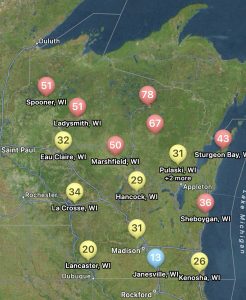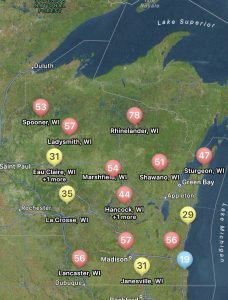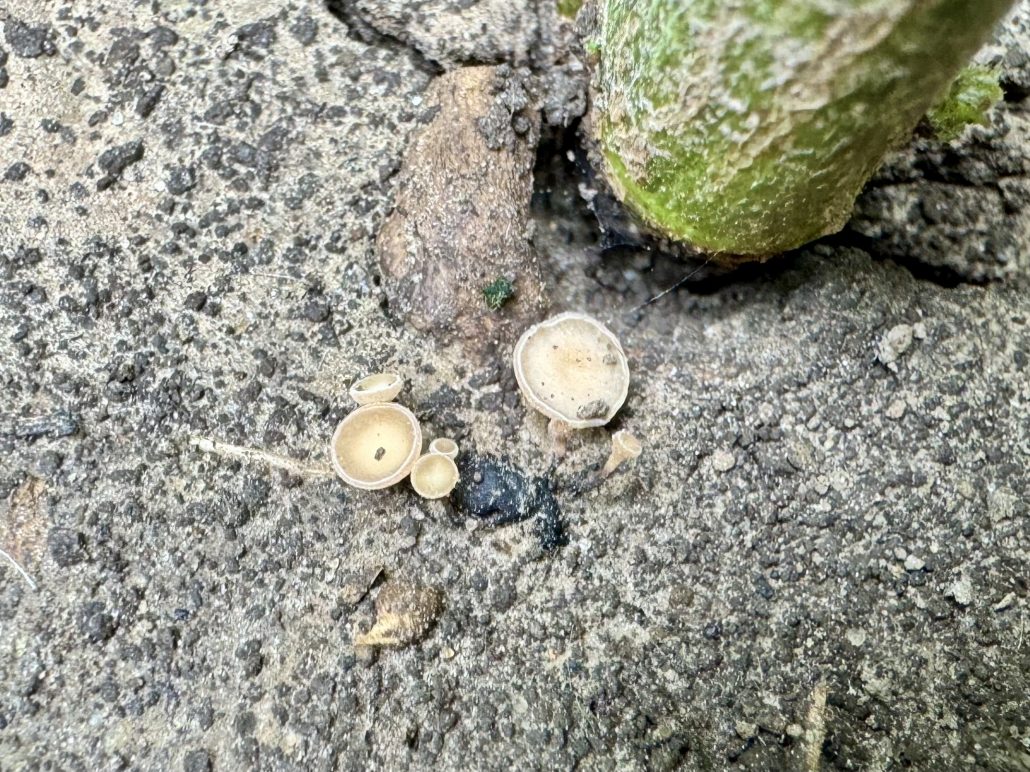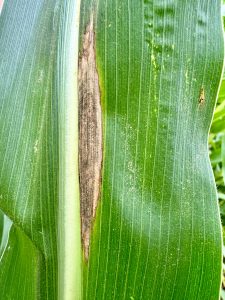Wisconsin Field Crop Disease Update – August 10, 2024
Damon Smith, Extension Field Crops Pathologist, Department of Plant Pathology, University of Wisconsin-Madison
Tar Spot of Corn
You can find the most recent updates on tar spot confirmations across the U.S. here: https://corn.ipmpipe.org/tarspot/. The Field Prophet tool is also showing mostly moderate risk across the southern two-thirds of Wisconsin, with just the northern tier with high risk for tar spot development at this point in the season (Fig. 1). This means that the weather is less conducive for tar spot development and spread. We are also quickly approaching the end of the in-season management window for applying fungicides in corn for tar spot control. For the major foliar diseases of corn, including tar spot, the optimal window to apply fungicides and maximize return on investment, is between the VT/R1 and R3 growth stages. If your crop has reached the milk growth stage and you are still not seeing any disease and the Tarspotter risk isn’t high, you can hold off on the fungicide application. The likelihood of a yield-limiting tar spot epidemic is low in this situation. You can learn more about fungicide application for tar spot control here.
White Mold of Soybeans
The risk for white mold according to Field Prophet is a bit higher compared to tar spot. Risk is generally high across the state with several pockets of low or medium risk. This means that weather has been conducive for the development of the mushroom-like structure (apothecia) of the white mold fungus that gives rise to spores that infect soybean. These risk estimates appear to be accurate as we continue to find apothecia in fields with a history of white mold (Figure 3). With that said, the soybean crop is quickly approaching the R4 growth stage or beyond, where the opportunity of infection by the white mold fungus does not exist. Thus, there is not a need to spray for white mold beyond the R4 growth stage. Similar to tar spot, the optimal timing of fungicide application ranges from the R1 growth stage to the R3 growth stage in soybeans. If you no longer see flowers on soybeans, then the risk for infection by the white mold fungus is low, despite conducive weather for the fungus.
Use Predictive Tools like a “Crystal Ball”
We continue to get questions about how the apps (Tarspotter, Sporecaster, and Field Prophet) should be used to make decisions about in-season disease management. We have designed these tools to be predictive. This means that the risk indexes you see are telling you that in the next week or two, you might see these diseases pop up. We developed these tools to act like a “crystal ball” so that you can look ahead and apply fungicides in a preventative manner. We know that fungicides work best when applied preventatively. In addition for diseases like tar spot, the fungus that causes this disease has a very long incubation period (time from infection to when you actually see tar spots). This time period can be as long as 30 days. So a high risk today, might indicate seeing tar spot show up even a month from now. Be sure to use these tools to look into the future and to prepare yourself, rather than being reactionary.
Other Diseases to Watch
We are starting to find more and more northern corn leaf blight (NCLB; Figure 4) in some fields in Wisconsin. This makes sense as the weather recently has been cooler and wetter. Luckily most of the fungicides used for tar spot also have good efficacy against NCLB. Thus if you sprayed for tar spot, you have probably controlled NCLB too. For those with silage corn, especially brown mid-rib (BMR) hybrids, continue to scout your fields for NCLB. Some BMR hybrids are very susceptible to this disease. If NCLB begins to move quickly and you are approaching your harvest window, you might consider chopping a bit earlier in order to reduce damage by NCLB.
We also continue to watch the frogeye leaf spot situation in soybeans. Our beta-testing models for frogeye leaf spot have shown relatively low risk for this disease in Wisconsin this season. We also have not found any frogeye leaf spot to date. However, the risk is creeping up in southern Wisconsin. The window to treat for this disease ends around R5. Thus, I believe most of the soybeans in Wisconsin will escape frogeye leaf spot without the need to apply a fungicide this season. However, keep an eye on your fields and continue to scout to stay informed of the situation.









